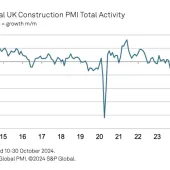UK construction output drops to five-year low
UK construction output fell sharply in February, according to the latest data from S&P Global. The UK Construction Purchasing Managers' Index (PMI) dropped to 44.6 in February from 48.1 in January, marking the lowest reading in nearly five years. A score below 50.0 indicates contraction.
The steep decline was driven by weak demand, rising costs and economic uncertainty. Residential construction was the hardest hit, with the sector’s index falling to 39.3, the lowest level since early 2009, excluding the pandemic period. Civil engineering activity also saw a sharp decline, with its index at 39.5, the weakest since October 2020. Commercial construction held up better, with its index at 49.0, showing only a modest decline.
Tim Moore, economics director at S&P Global Market Intelligence, said: “Sharply declining order books rippled through the UK construction sector in February, leading to accelerated reductions in output volumes, employment and input buying.”

Demand for new work fell at the fastest rate since May 2020, as clients delayed decisions due to squeezed budgets and economic uncertainty. Construction firms reduced staffing levels for the second consecutive month, with the sharpest cuts in workforce numbers since November 2020. Many firms said they were not replacing staff who left voluntarily because of cost pressures and a lack of new projects.
Input costs increased at the fastest rate since March 2023. Around 38% of survey respondents reported higher prices for raw materials, energy, transport and wages, while only 3% saw a reduction. Input buying fell for the third month running, contributing to an improvement in supplier delivery times – the first since October 2024.
Despite the downturn, 39% of construction companies expect output to rise over the next year, although confidence is lower than in 2024.
Moore said: “Hopes of an improvement in underlying market conditions and lower borrowing costs are supporting confidence, but weak consumer spending and risk aversion among clients remain concerns.”







